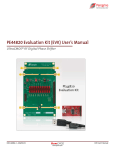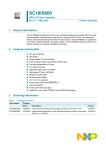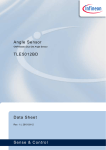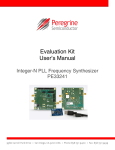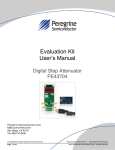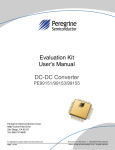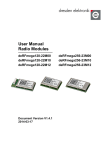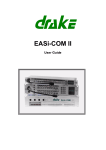Download (EVK) User`s Manual - Peregrine Semiconductor
Transcript
PE46120 Evaluation Kit (EVK) User’s Manual Monolithic Phase & Amplitude Controller, 1.7–2.2 GHz PE46120 Evaluation Kit DOC-68985-1 – (08/2015) EVK User’s Manual www.psemi.com PE46120 EVK User’s Manual Copyright and Trademarks ©2015, Peregrine Semiconductor Corporation. All rights reserved. The Peregrine name, logo, UTSi and UltraCMOS are registered trademarks and HaRP, MultiSwitch and DuNE are trademarks of Peregrine Semiconductor Corp. Disclaimers The information in this document is believed to be reliable. However, Peregrine assumes no liability for the use of this information. Use shall be entirely at the user’s own risk. No patent rights or licenses to any circuits described in this document are implied or granted to any third party. Peregrine’s products are not designed or intended for use in devices or systems intended for surgical implant, or in other applications intended to support or sustain life, or in any application in which the failure of the Peregrine product could create a situation in which personal injury or death might occur. Peregrine assumes no liability for damages, including consequential or incidental damages, arising out of the use of its products in such applications. Patent Statement Peregrine products are protected under one or more of the following U.S. patents: patents.psemi.com Sales Contact For additional information, contact Sales at [email protected]. Corporate Headquarters 9369 Carroll Park Drive, San Diego, CA, 92121 858-731-9400 Page ii DOC-68985-1 – (08/2015) www.psemi.com PE46120 EVK User’s Manual Table of Contents Introduction - - - - - - - - - - - - - - - - - - - - - - - - - - - - - - - - - - - - - - - - - - - - - - - - - - - - - - 1 Introduction - - - - - - - - - - - - - - - - - - - - - - - - - - - - - - - - - - - - - - - - - - - - - - - - - - - - - - - - - - - - - - - - - - - - - - 1 Application Support . . . . . . . . . . . . . . . . . . . . . . . . . . . . . . . . . . . . . . . . . . . . . . . . . . . . . . . . . . . . . . . . . . . . . . . . . . . . . . . . . . 1 Evaluation Kit Contents and Requirements . . . . . . . . . . . . . . . . . . . . . . . . . . . . . . . . . . . . . . . . . . . . . . . . . . . . . . . . . . . . . 1 Kit Contents . . . . . . . . . . . . . . . . . . . . . . . . . . . . . . . . . . . . . . . . . . . . . . . . . . . . . . . . . . . . . . . . . . . . . . . . . . . . . . . . . . . . . . . . . . . . . . . . . . . . 1 Software Requirements . . . . . . . . . . . . . . . . . . . . . . . . . . . . . . . . . . . . . . . . . . . . . . . . . . . . . . . . . . . . . . . . . . . . . . . . . . . . . . . . . . . . . . . . . . 2 Hardware Requirements . . . . . . . . . . . . . . . . . . . . . . . . . . . . . . . . . . . . . . . . . . . . . . . . . . . . . . . . . . . . . . . . . . . . . . . . . . . . . . . . . . . . . . . . . 2 Evaluation Board Assembly - - - - - - - - - - - - - - - - - - - - - - - - - - - - - - - - - - - - - - - - - - 3 Evaluation Board Assembly Overview - - - - - - - - - - - - - - - - - - - - - - - - - - - - - - - - - - - - - - - - - - - - - - - - - - 3 Quick Start Guide - - - - - - - - - - - - - - - - - - - - - - - - - - - - - - - - - - - - - - - - - - - - - - - - - 5 Quick Start Overview - - - - - - - - - - - - - - - - - - - - - - - - - - - - - - - - - - - - - - - - - - - - - - - - - - - - - - - - - - - - - - - 5 Software Installation - - - - - - - - - - - - - - - - - - - - - - - - - - - - - - - - - - - - - - - - - - - - - - - - - - - - - - - - - - - - - - - 5 USB Driver . . . . . . . . . . . . . . . . . . . . . . . . . . . . . . . . . . . . . . . . . . . . . . . . . . . . . . . . . . . . . . . . . . . . . . . . . . . . . . . . . . . . . . . . . . . . 5 EVK Software . . . . . . . . . . . . . . . . . . . . . . . . . . . . . . . . . . . . . . . . . . . . . . . . . . . . . . . . . . . . . . . . . . . . . . . . . . . . . . . . . . . . . . . . . 5 Hardware Configuration - - - - - - - - - - - - - - - - - - - - - - - - - - - - - - - - - - - - - - - - - - - - - - - - - - - - - - - - - - - - 8 USB Interface Board Overview . . . . . . . . . . . . . . . . . . . . . . . . . . . . . . . . . . . . . . . . . . . . . . . . . . . . . . . . . . . . . . . . . . . . . . . . . 8 Evaluation Board Overview . . . . . . . . . . . . . . . . . . . . . . . . . . . . . . . . . . . . . . . . . . . . . . . . . . . . . . . . . . . . . . . . . . . . . . . . . . . . 9 Hardware Operation . . . . . . . . . . . . . . . . . . . . . . . . . . . . . . . . . . . . . . . . . . . . . . . . . . . . . . . . . . . . . . . . . . . . . . . . . . . . . . . . . 11 Using the Graphical User Interface - - - - - - - - - - - - - - - - - - - - - - - - - - - - - - - - - - - - - - - - - - - - - - - - - - - - 15 Continuous Pattern Loop . . . . . . . . . . . . . . . . . . . . . . . . . . . . . . . . . . . . . . . . . . . . . . . . . . . . . . . . . . . . . . . . . . . . . . . . . . . . . . . . . . . . . . . 16 Send Signal . . . . . . . . . . . . . . . . . . . . . . . . . . . . . . . . . . . . . . . . . . . . . . . . . . . . . . . . . . . . . . . . . . . . . . . . . . . . . . . . . . . . . . . . . . . . . . . . . . . . 16 Attenuation and Phase Slide Bar . . . . . . . . . . . . . . . . . . . . . . . . . . . . . . . . . . . . . . . . . . . . . . . . . . . . . . . . . . . . . . . . . . . . . . . . . . . . . . . . 17 Technical Resources - - - - - - - - - - - - - - - - - - - - - - - - - - - - - - - - - - - - - - - - - - - - - - - 19 Technical Resources - - - - - - - - - - - - - - - - - - - - - - - - - - - - - - - - - - - - - - - - - - - - - - - - - - - - - - - - - - - - - - - 19 Document Categories - - - - - - - - - - - - - - - - - - - - - - - - - - - - - - - - - - - - - - - - - - - - - 21 DOC-68985-1 – (08/2015) Page iii www.psemi.com PE46120 EVK User’s Manual This page intentionally left blank. Page iv DOC-68985-1 – (08/2015) www.psemi.com PE46120 EVK User’s Manual Introduction 1 Introduction The PE46120 is a HaRP™ technology-enhanced monolithic phase and amplitude controller (MPAC) designed for precise phase and amplitude control of two independent RF paths. It optimizes system performance while reducing manufacturing costs of transmitters that use symmetric or asymmetric power amplifier designs to efficiently process signals with large peak-to-average ratios. This monolithic RFIC integrates a 90° RF splitter, digital phase shifters and a digital step attenuator along with a low voltage CMOS serial interface. It can cover a phase range of 87.2° in 2.8° steps and an attenuation range of 7.5 dB in 0.5 dB steps, while providing excellent phase and amplitude accuracy from 1.8–2.2 GHz. The PE46120 also features exceptional linearity, high output port-to-port isolation and extremely low power consumption relative to competing module solutions. It is offered in a 32-lead 6 × 6 mm QFN package. The PE46120 evaluation kit (EVK) includes hardware required to control and evaluate the functionality of the MPAC. The MPAC evaluation software can be downloaded at www.psemi.com and requires a PC running Windows® operating system to control the USB interface board. Application Support For any technical inquiries regarding the evaluation kit or software, please visit applications support at www.psemi.com (fastest response) or call (858) 731-9400. Evaluation Kit Contents and Requirements Kit Contents The PE46120 EVK includes the following hardware required to evaluate the MPAC. Table 1 • PE46120 Evaluation Kit Contents Quality Description 1 PE46120 MPAC evaluation board assembly (PRT-55151) 1 Peregrine USB interface board assembly (PRT-50866) 1 USB 2.0 Type A to Type B mini cable DOC-68985-1 – (08/2015) Page 1 www.psemi.com PE46120 EVK User’s Manual Software Requirements The MPAC evaluation software will need to be installed on a computer with the following minimum requirements: • PC compatible with Windows™ XP, Vista, 7 or 8 • Mouse or other pointing device • USB port • HTML browser with internet access • Administrative privileges Hardware Requirements In order to evaluate the performance of the evaluation board, a Vector network analyzer is required. Caution: The PE46120 MPAC EVK contains components that might be damaged by exposure to voltages in excess of the specified voltage, including voltages produced by electrostatic discharges. Handle the board in accordance with procedures for handling static-sensitive components. Avoid applying excessive voltages to the power supply terminals or signal inputs or outputs. Page 2 DOC-68985-1 – (08/2015) www.psemi.com PE46120 EVK User’s Manual Evaluation Board Assembly 2 Evaluation Board Assembly Overview The evaluation board (EVB) is assembled with a PE46120, several headers and SMA connectors, as shown in Figure 1. Figure 1 • PE46120 Evaluation Board Assembly DOC-68985-1 – (08/2015) Page 3 www.psemi.com PE46120 EVK User’s Manual This page intentionally left blank. Page 4 DOC-68985-1 – (08/2015) www.psemi.com PE46120 EVK User’s Manual Quick Start Guide 3 Quick Start Overview The EVB was designed to ease customer evaluation of the PE46120 MPAC. This chapter will guide the user through the software installation, hardware configuration and using the graphical user interface (GUI). Software Installation computer. The USB interface and MPAC application software is compatible with computers running Windows®, XP, Vista, 7, 8, in 32- or 64-bit configurations. This software is available directly from Peregrine’s website at www.psemi.com. To install the MPAC evaluation software, unzip the archive and execute the “setup.exe” (Figure 3). Figure 3 • MPAC Evaluation Software Installer USB Driver The latest USB interface board drivers are available via Microsoft Windows update. Internet connectivity is required to download the drivers. Connect the USB interface board to the PC and select the Windows Update option to obtain and install the drivers (Figure 2). If the USB board drivers are not installed, it will not be possible to complete the installation of the MPAC EVK software. A USB interface board (Figure 11) is included in the evaluation kit. After the setup.exe file has been executed, a welcome screen will appear. It is strongly recommended that all programs be closed prior to running the install program. Click the “Next>” button to proceed. Figure 4 • MPAC Evaluation Software Setup Figure 2 • USB Driver Installation (Detecting) EVK Software In order to evaluate the PE46120 performance, the application software has to be installed on your DOC-68985-1 – (08/2015) Page 5 www.psemi.com PE46120 EVK User’s Manual Take a moment to read the license agreement, then click “I Agree” and “Next>” In the window of Confirm Installation, click “Next>” to proceed with the software installation. . Figure 5 • License Agreement Figure 7 • Confirm Installation For most users the default install location for the program files is sufficient. If a different location is desired, the install program can be directed to place the program files in an alternate location. The software is installed for “Everyone” by default. Once the desired location is selected click “Next>.” As the software files are installed, a progress indicator will be displayed. On slower computers, installation of the software may proceed for a few moments. Figure 8 • Progress Indicator Figure 6 • Select Installer Folder Page 6 DOC-68985-1 – (08/2015) www.psemi.com PE46120 EVK User’s Manual Once the evaluation software is installed, click “Close” to exit. Figure 9 • Installation Complete A new Start Menu item under Peregrine Semiconductor will appear in the start menu of your computer. Select “MPAC Evaluation Software” to launch the GUI. Figure 10 • MPAC Evaluation Software Launch DOC-68985-1 – (08/2015) Page 7 www.psemi.com PE46120 EVK User’s Manual Hardware Configuration USB Interface Board Overview The USB interface board (Figure 11) is included in the evaluation kit. This board allows the user to send serial peripheral interface (SPI) commands to the device under test by using a PC running the Windows® operating system. To install the software, extract the zip file to a temporary directory and follow the installation procedure included. Figure 11 • USB Interface Board Connection of the USB Interface Board to the Evaluation Board The EVB and the USB interface board contain a 14 pin header. This feature allows the USB interface board (socket) to connect directly to the EVB (pin) on the front side as show in Figure 12. Use caution when making the connection to insure the USB interface board is aligned and connected to both rows of pins properly. Figure 12 • USB Interface Board Connected to the Evaluation Board Page 8 DOC-68985-1 – (08/2015) www.psemi.com PE46120 EVK User’s Manual Evaluation Board Overview The evaluation board is designed to ease customer evaluation of Peregrine’s products. The board contains: 1) Digital signal connectors are provided for power supply, digital control signals and USB interface board. 2) SMA connectors are provided for RF performance verification and THRU trace to calibrate board trace loss. The schematic and evaluation board outline are provided in this user manual. 13 11 9 7 5 3 1 R11 C13 0 OHM DNI R10 C14 0 OHM DNI R9 C15 JP9 DNI 26 27 28 25 NC NC NC NC NC 31 29 30 RFOUT2 23 NC NC 22 4 RFIN DS 21 5 RFIN 6 NC C10 C11 DNI DNI GND 19 7 SDO RFOUT1 18 8 CLK RFOUT1 17 1 MEGA J11 J5 HEADER 2 SHORT 2 PIN JUMPER JP5 J6 1 2 THRU JP4 1 2 2 PIN JUMPER GND 33 USB - RED C4 0 OHM DNI DNI R4 C5 1 2 1 2 DEVICE TEST FUNCTIONALITY 0.1uF 2 4 6 8 10 12 14 1 3 5 7 9 11 13 1 3 5 7 9 11 13 0 OHM VDD_IFB1 HEADER 14 2 4 6 8 10 12 14 J1 JP1 C2 DNI R5 C6 0 OHM DNI C7 DNI JP2 J10 1 1 2 2 C8 JP3 J8 VDD DNI VDD C1 100pF R3 J7 50 Ohm 2 PIN JUMPER 50 Ohm VDD_IFB1 50 Ohm JP6 1 2 /SPEN 20 NC R6 SDO 3 16 0 OHM 2 9 DNI 24 SDI C3 1 1 2 2 RFOUT2 NC R2 U1 PE46120 R1 DNI OPEN CLK 15 50 Ohm 50 Ohm J2 1 NC 1 MEGA NC DNI 13 R7 LE 0 OHM VDD SDI 32 C16 J4 50 Ohm JP7 DNI R8 J3 JP8 1 2 VDD 0 OHM 12 0.1uF 11 100pF 1 2 DNI LE C18 10 C17 3 PIN JUMPER DNI HEADER 14 USB - RED 1 2 3 C12 NC 13 11 9 7 5 3 1 14 14 12 10 8 6 4 2 VDD VDD_IFB2 J9 14 12 10 8 6 4 2 VDD_IFB2 Figure 13 • PE46120 Evaluation Board Schematic 100pF C9 PIN FUNCTIONALITY 12 TEST ENABLE 1 13 TEST OUT 1 19 POLARITY SELECT 28 TEST OUT 2 29 TEST ENABLE 2 HEADER 2 0.1uF 1 2 3 3 PIN JUMPER INSTALL LOGIC JUMPERS ON REF DES NOTES: 1. CAUTION: CONTAINS PARTS AND ASSEMBLIES SUSCEPTIBLE TO DAMAGE BY ELECTROSTATIC DISCHARGE (ESD) PINS JP3 2-3 JP4 1-2 JP5 1-2 JP6 1-2 JP9 2-3 DOC-68985-1 – (08/2015) Page 9 www.psemi.com PE46120 EVK User’s Manual Figure 14 • PE46120 Evaluation Board Outline Showing Functional Overview USB Interface Board Connector VDD can be applied by external power supply VDD is applied from USB board power supply DS=0 RF Out 2 RF In RF Out 1 VDD is applied from USB board power supply /SPEN=0 USB Interface Board Connector “THRU” trace is for board trace loss calibration Page 10 DOC-68985-1 – (08/2015) www.psemi.com PE46120 EVK User’s Manual Hardware Operation The general guidelines for operating the hardware evaluation board are listed in this section. Follow the steps below to configure the hardware properly for the performance. 1) Connect the jumper on JP4, JP5 and JP6. a) JP4 is connected to PE46120 pin-19 (GND) to ground. b) JP5 is connected to PE46120 pin-20 (/SPEN) to ground for normal SPI operation. Refer to datasheet Table 11. c) JP6 is connected to PE46120 pin-21 (DS) to ground as DS = 0 setting. Refer to Table 6 and Table 7. 2) There are two options to provide PE46120 a power supply. They are: a) Option 1: Power up through USB interface board. Evaluation board is using this option by connecting jumper on JP3 pin 2–3 and jumper on JP9 pin 2–3; refer to Figure 14. b) Option 2: Power via external power supply. The evaluation board is configured for this option by installing a jumper on JP3 pins 1–2 and JP9 pins 1–2 (refer to Figure 14). Connect the external power supply to VDD_EXT J10 or J11 (pin 1+, pin 2–). 3) Plug in USB interface board (Figure 11) on J8 or J9, as shown in Figure 12. J8 and J9 provide identical control to the device. 4) Calibrate board trace loss and phase with THRU trace between J6 and J7. THRU calibration is sufficient for initial measurements. If more accurate results are desired, the full set of SLOT standards can be used. Table 2 • Recommended Operating Condition for PE46120 Parameter Min Supply voltage, VDD(1) Typ 2.3 Supply current 350 Max Unit 5.5 V 500 µA Digital input high 1.17 3.6 V Digital input low 0 0.6 V 20 µA RF input power, CW 29 dBm RF input power, pulsed(2) 32 dBm +105 °C Digital input leakage 10 Operating temperature range –40 +25 Notes: 1) Product performance does not vary over VDD. 2) Pulsed, 5% duty cycle of 4620 µs period. DOC-68985-1 – (08/2015) Page 11 www.psemi.com PE46120 EVK User’s Manual Table 3 • Bit Descriptions C0 Channel register select C0 = L, channel RFOUT1 register select C0 = H, channel RFOUT2 register select M0–M3 Attenuation setting per channel P0–P4 Phase shift setting per channel S0–S3 Spare bits Table 4 • 14-bit Word Q13 Q12 Q11 Q10 Q9 Q8 Q7 Q6 Q5 Q4 Q3 Q2 Q1 Q0 C0 S3 S2 M3 M2 M1 M0 P4 P3 P2 P1 P0 S1 S0 1 — — — — — — 45 22.5 11.2 5.6 2.8 — — 2 — — 4 2 1 0.5 45 22.5 11.2 5.6 2.8 — — Table 5 • Serial Truth Table—Phase Setting Q13 Q12 Q11 Q10 Q9 Q8 Q7 Q6 Q5 Q4 Q3 Q2 Q1 Q0 P3 P2 P1 P0 S1 S0 5.6 2.8 — — Phase Shift Setting C0 S3 S2 M3 M2 M1 M0 P4 1/2 — — 4 2 1 0.5 45 X X X X X X X L L L L L X X Ref phase X X X X X X X L L L L H X X 2.8 deg X X X X X X X L L L H L X X 5.6 deg X X X X X X X L L H L L X X 11.25 deg X X X X X X X L H L L L X X 22.5 deg X X X X X X X H L L L L X X 45 deg X X X X X X X H H H H H X X 87.2 deg 22.5 11.2 Page 12 DOC-68985-1 – (08/2015) www.psemi.com PE46120 EVK User’s Manual Table 6 • Serial Truth Table—Attenuation Setting (RFOUT2) Q13 Q12 Q11 Q10 Q9 Q8 Q7 Q6 Q5 Q4 Q3 Q2 Q1 Q0 P3 P2 P1 P0 S1 S0 C0 S3 S2 M3 M2 M1 M0 P4 1 — — — — — — 45 22.5 11.2 5.6 2.8 — — 2 — — 4 2 1 0.5 45 22.5 11.2 5.6 2.8 — — H X X L L L L X X X X X X X Ref insertion loss H X X L L L H X X X X X X X 0.5 dB H X X L L H L X X X X X X X 1 dB H X X L H L L X X X X X X X 2 dB H X X H L L L X X X X X X X 4 dB H X X H H H H X X X X X X X 7.5 dB Amplitude Setting Table 7 • Default State Settings at Power Up (RFOUT1) Q13 Q12 Q11 Q10 DS Setting Q9 Q8 Q7 Q6 Q5 Q4 Q3 Q2 Q1 Q0 P3 P2 P1 P0 S1 S0 5.6 2.8 — — Default Setting at Power Up C0 S3 S2 M3 M2 M1 M0 P4 1/2 — — 4 2 1 0.5 45 DS = 0 — — — — — — — L L L L L — — 0 dB 0 deg DS = 1 — — — — — — — H L L L L — — 0 dB 45 deg 22.5 11.2 Table 8 • Default State Setting at Power Up (RFOUT2) Q13 Q12 Q11 Q10 DS Setting Q9 Q8 Q7 Q6 Q5 Q4 Q4 Q3 Q2 Q1 P3 P2 P1 P0 S1 S0 5.6 2.8 — — Default Setting at Power Up C0 S3 S2 M3 M2 M1 M0 P4 1/2 — — 4 2 1 0.5 45 DS = 0 — — — L L L L L L L L L — — 0 dB 0 deg DS = 1 — — — H H H H H L L L L — — 7.5 dB 45 deg DOC-68985-1 – (08/2015) 22.5 11.2 Page 13 www.psemi.com PE46120 EVK User’s Manual Table 9 • Serial Interface Timing Characteristics(1) Parameter/Condition Min Max Unit Serial clock frequency, FCLK(2) 0.032 26 MHz Serial clock period, TSCLK 40 ns Serial clock HIGH time, TSCLKH 20 ns Serial clock LOW time, TSCLKL 20 ns Serial data output propagation delay from CLK falling edge, TOV (10 pF) Latch clock pulse width high, TLCLKH 9 10 ns ns Serial data input setup time from CLK rising edge, TSU 5 ns Serial data input hold time from CLK rising edge, TH 2 ns Serial data output hold time from CLK rising edge, TOH 1.6 ns Serial clock rising edge setup time to latch clock rising edge, TSETTLE 27 ns SDO drive strength(3) 15 pF Notes: 1) VDD = 2.3V–5.5V, –40 °C < TA < +1-5 °C, unless otherwise specified. 2) Limited by test duration not static logic design. Synchronous to clock. Minimum clock frequency tested = 32 kHz. 3) SDO maximum capacitive load drive strength for FCLK = MHz with a 1.8V swing. Page 14 DOC-68985-1 – (08/2015) www.psemi.com PE46120 EVK User’s Manual Using the Graphical User Interface Figure 15 displays the MPAC application software graphical user interface (GUI), which has the USB interface board plugged into the computer. The message “USB-SPI Interface Board #101-0653 connected” will indicate that the USB interface board is connected and recognized. “Hardware Operation” as shown on page 11 is for the EVK hardware configuration to use with the GUI control software. If the USB interface board is not connected when the application software is launched, the message “No interface board connected! Please connect USBSPI Interface #101-0653” will appear at the bottom of the screen. In the upper left corner, under the Peregrine logo, there is a drop-down menu item to select the part number for evaluation and the part description is below the part number box. The MPAC application software graphical user interface (GUI) is displayed in Figure 15 and illustrates the available controls and messages available to the user. Figure 15 • MPAC Application Software Graphical User Interface(*) Note: * SDO in the serial interface waveform is read back from the MPAC to verify SDO toggling to indicate proper communication with the MPAC. DOC-68985-1 – (08/2015) Page 15 www.psemi.com PE46120 EVK User’s Manual Continuous Pattern Loop Send Signal The continuous pattern loop checkbox (see Figure 16) allows the user to observe the evaluation board automatically step through each of the phase and attenuation states. Once the GUI reaches the maximum state value the cycle begins again at the minimum state value. This function can be started and stopped at any time by selecting/deselecting the checkbox. The “Send Signal” box can be used to resend the same data. Figure 17 • Send Signal Figure 16 • Continuous Pattern Loop Page 16 DOC-68985-1 – (08/2015) www.psemi.com PE46120 EVK User’s Manual Attenuation and Phase Slide Bar The RF Out Path slide bar allows the user to quickly select the desired attenuation and phase. The arrows at the left and right can be clicked to increase or decrease phase or attenuation state at the minimum step size. The attenuation and phase value text box is updated with each change of the phase slider. This control is two-way; the user can also enter a valid attenuation and phase value into this text box followed by the ENTER key to program the hardware with the updated value. Figure 18 • RFOUT1 Path Slide Bar Figure 19 • RFOUT2 Path Slide Bar DOC-68985-1 – (08/2015) Page 17 www.psemi.com PE46120 EVK User’s Manual This page intentionally left blank. Page 18 DOC-68985-1 – (08/2015) www.psemi.com PE46120 EVK User’s Manual Technical Resources 4 Technical Resources Additional technical resources are available for download in the Products section at www.psemi.com. These include the Product Specification datasheet, S-parameters, zip file, evaluation kit schematic and bill of materials, material declaration form and PC-compatible software file. Trademarks are subject to trademark claims. DOC-68985-1 – (08/2015) Page 19 www.psemi.com PE46120 EVK User’s Manual This page intentionally left blank. Page 20 DOC-68985-1 – (08/2015) www.psemi.com PE46120 EVK User’s Manual Document Categories Advance Information The product is in a formative or design stage. The document contains design target specifications for product development. Specifications and features may change in any manner without notice. Preliminary Specification The document contains preliminary data. Additional data may be added at a later date. Peregrine reserves the right to change specifications at any time without notice in order to supply the best possible product. Product Specification The document contains final data. In the event Peregrine decides to change the specifications, Peregrine will notify customers of the intended changes by issuing a CNF (Customer Notification Form). Not Recommended for New Designs (NRND) This product is in production but is not recommended for new designs. End of Life (EOL) This product is currently going through the EOL process. It has a specific last-time buy date. Obsolete This product is discontinued. Orders are no longer accepted for this product. DOC-68985-1 – (08/2015) Page 21 www.psemi.com

























